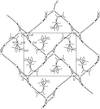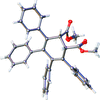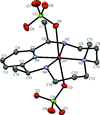issue contents
July 2016 issue

Cover illustration: A tetrahedral silver(I) molecule comprising coordinated bromide, two phosphanes and an S-bound benzenecarbothioamide is found in the compound (benzenecarbothioamide-![[kappa]](/logos/entities/kappa_rmgif.gif) S)bromidobis(triphenylphosphane-
S)bromidobis(triphenylphosphane-![[kappa]](/logos/entities/kappa_rmgif.gif) P)silver(I). Stability to the coordination geometry is afforded by a hydrogen-bonded S(6) loop, i.e. {...BrAgSCNH...} leading to a quasi-chelate ring. Intermolecular N-H
P)silver(I). Stability to the coordination geometry is afforded by a hydrogen-bonded S(6) loop, i.e. {...BrAgSCNH...} leading to a quasi-chelate ring. Intermolecular N-H Br, C-H
Br, C-H Br and C-H
Br and C-H
![[pi]](/logos/entities/pi_rmgif.gif) interactions stabilize the molecular packing; these have also been analysed by Hirshfeld surface analysis. See: Ruangwut, Saithong & Pakawatchai [Acta Cryst. (2016). E72, 984-987].
interactions stabilize the molecular packing; these have also been analysed by Hirshfeld surface analysis. See: Ruangwut, Saithong & Pakawatchai [Acta Cryst. (2016). E72, 984-987].
research communications
Download citation


Download citation


The molecular structure of Ag2(SCN)2(NH3)4 consists of [Ag(SCN)(NH3)2]2 dimers with an Ag⋯Ag separation of 3.0927 (6) Å.
CCDC reference: 1482850
Download citation


Download citation


The title compound, C28H16O8·Cs+CH3O−·2CH3CH2OH, was formed in the supramolecular reaction between a vasarene analogue and caesium fluoride, where the F− ion has been replaced by acetate.
CCDC reference: 1479382
Download citation


Download citation


The asymmetric unit of the monomeric cobalt complex, [Co(C11H13O2)2(C6H6N2O)2(H2O)2]·2H2O, contains one half of the complex molecule, one coordinating and one non-coordinating water, one 4-tert-butylbenzoate (TBB) ligand and one nicotinamide (NA) ligand; the Co atom lies on an inversion centre. The coordinating water molecules are hydrogen bonded to the carboxyl O atoms [O ⋯ O = 2.6230 (17) Å], enclosing an S(6) hydrogen-bonding motif, while intermolecular O—H⋯O hydrogen bonds link two of the non-coordinating water molecules to the coordinating water molecules and NA anions. In the crystal, O—H⋯O and N—H⋯O hydrogen bonds link the molecules, enclosing  (8),
(8),  (10) and
(10) and  (12) ring motifs, forming layers parallel to (001).
(12) ring motifs, forming layers parallel to (001).
CCDC reference: 1482507
Download citation


Download citation


A cyanide-bridged anionic three-dimensional network solid is described, with molecular formula {Cu2(CN)3}−. Charge neutrality is provided by guest N-protonated N,N-diethylethanolamine molecules.
CCDC reference: 1482622
Download citation


Download citation


The title compound, [Sn(C4H9)2(C6H5COO)2], was synthesized in order to study the interaction between di-n-butyltin(IV) oxide and some carboxylic acids. Di-n-butyltin(IV) dibenzoate, nBu2Sn(obz)2, exhibits the same structural features as other diorganotin(IV) dibenzoates characterized by an unsymmetrical bidentate bonding mode [Δ(Sn—O) ≃ 0.4 Å] of the two benzoate groups to tin.
CCDC reference: 1482358
Download citation


Download citation


The title compound is a resolved chiral ester derivative of mandelic acid containing an acetate group and a carboxylic acid group, which engage in intermolecular hydrogen bonding, forming chains extending parallel to [001].
CCDC reference: 1482445
Download citation


Download citation


The title salt consists of isolated octahedrally shaped [Mn(DMSO)6]2+ cations (DMSO is dimethyl sulfoxide) and two I− anions, held together through weak C—H⋯I interactions.
CCDC reference: 1483114
Download citation


Download citation


In [Co(C8H8BrN4O)2]NO3·C3H7NO, the ligand molecules are deprotonated at the phenol O atom and octahedrally coordinate the CoIII atoms through the azomethine N and phenolate O atoms in a mer configuration. In the crystal lattice, the cations are arranged in layers in the ab plane divided by the nitrate anions and solvent molecules. All of the amine H atoms are involved in hydrogen bonding to nitrate, DMF or ligand O atoms or to one of the Br atoms, forming two-dimensional networks.
CCDC reference: 1482509
Download citation


Download citation


Crystal structures of organoplatinum complexes containing alkyleugenoxyacetate and p-chloroaniline
In the title trans-dichloridoplatinum(II) complexes, the central PtII atom is further coordinated by the p-chloroaniline N atom and ethylenic double bond of alkyleugenoxyacetate.
Download citation


Download citation


In the title solvate, the oxamide derivative presents the same conformation as in the unsolvated molecule, but the lattice solvent introduces disorder for various functional groups.
CCDC reference: 1482681
Download citation


Download citation


The crystal structure consists of discrete tetrahedral complexes, that are linked by intermolecular N—H⋯O, C—H⋯O and N—H⋯O hydrogen bonding.
CCDC reference: 1483379
Download citation


Download citation


Three coumarin derivatives display intramolecular N—H⋯O and weak C—H⋯O hydrogen bonds, which probably contribute to the approximate planarity of the molecules. The supramolecular structures feature C—H⋯O hydrogen bonds and π–π interactions, as confirmed by Hirshfeld surface analyses.
Download citation


Download citation


In the crystal of the title compound, a supramolecular sheet structure is formed through N—H⋯O, O—H⋯O and C—H⋯O hydrogen bonds.
CCDC reference: 1483293
Download citation


Download citation


The molecular structure of the piperazine[5,10,15,20-(tetraphenylbenzoate)porphyrinato-κ4N]zinc(II) complex is composed of parallel pairs of layers with an interlayer distance of 4.100 Å while the distance between two pairs of layers is 4.047 Å.
CCDC reference: 1483991
Download citation


Download citation


The crystal structure of disodium hydrogen citrate sesquihydrate has been solved and refined using laboratory X-ray single-crystal diffraction data, and optimized using density functional techniques.
Download citation


Download citation


In the title compound, C34H28O4, the cyclohexadiene ring has a screw-boat conformation. All four phenyl rings in the two independent molecules are arranged in a propeller-like conformation. The two molecules exhibit S,R- and R,S- chirality and are connected via C—H⋯O intermolecular interactions.
CCDC reference: 1484412
Download citation


Download citation


The title p-hydroxy Schiff base, is the product of a condensation reaction between benzocaine and vanillin. The benzylidine and benzoate rings are inclined to one another by 24.58 (8)°, and the conformation about the C=N bond is E.
CCDC reference: 1483394
Download citation


Download citation


The title compounds C17H14BrNO2 (I), and C17H15NO3 (II), were obtained from the reaction of 6-methoxy-3,4-dihydro-2H-naphthalen-1-one and 2-bromonicotinaldehyde in ethanol. Compound (I) was the expected product and compound (II) was the oxidation product from air exposure.
Download citation


Download citation


The crystal structure of ruizite, ideally Ca2Mn3+2[Si4O11(OH)2](OH)2·2H2O was redetermined based on single-crystal X-ray diffraction data of a natural sample from the Wessels mine, Northern Cape Province, South Africa, in space group C2. All non-H atoms were refined with anisotropic displacement parameters and all hydrogen atoms were located, improving upon previous results and yielding a significantly lower R factor.
CCDC reference: 1483820
Download citation


Download citation


The weak intermolecular interactions in two indole derivatives are described.
Download citation


Download citation


In the crystal, a combination of N—H⋯O and O—H⋯O hydrogen bonds links the molecules of the title compounds into a chain of rings.
CCDC reference: 1483503
Download citation


Download citation


The reaction of AgI with the pyridylimidazol ligand 4-(1-(5′-isopropyl-[1,1′:3′,1′′-terphenyl]-2′-yl)-1H-imidazol-2-yl)pyridine, afforded a nitrate-free one-dimensional looped-chain polymeric structure. The AgI cation adopts a highly distorted tetrahedral geometry coordinated by two pyridine N atoms and two imidazole N atoms from four individual ligands.
CCDC reference: 1484735
Download citation


Download citation


The central cyclohexane ring has a chair conformation. In the crystal, molecules are linked by C—H⋯O hydrogen bonds and C—H⋯π interactions, forming layers parallel to (100).
CCDC reference: 1484675
Download citation


Download citation


The title isonicotinohydrazides adopt an E conformation about the C=N bonds and in each molecule there is an intramolecular O—H⋯N hydrogen bond, forming an S(6) ring motif. In the crystals of both compounds, zigzag chains are formed via N—H⋯N hydrogen bonds, in the [10 ] the first compound and [010] for the other.
] the first compound and [010] for the other.
Download citation


Download citation


The mononuclear complex exhibits a distorted tetrahedral coordination geometry about the metal atom, arising from one S atom of the benzenecarbothioamide ligand, two P atoms of two triphenylphosphane molecules and one bromide ion. An intramolecular N—H⋯Br hydrogen bond is observed and in the crystal structure, inversion dimers linked by pairs of N—H⋯Br and C—H⋯Br hydrogen bonds are observed. In addition, C—H⋯π interactions occur, leading to [101] chains.
CCDC reference: 1484796
Download citation


Download citation


We report the syntheses and characterization of three solution-processable phenoxy silicon phthalocyanines (SiPcs). The π–π interactions between the aromatic SiPc cores were studied. In all three cases, the solubility of the molecules was increased by the addition of phenoxy groups while maintaining π–π interactions between the aromatic SiPc groups.
Download citation


Download citation


The title compound crystallizes in the space group P63mc and is isotypic with Li2SnMo3O8 and Li2InMo3O8. Its crystal structure contains triangular Mo3 clusters units whereby the tetravalent oxidation state of the germanium atom leads to 8 electrons per Mo3 cluster.
CCDC reference: 1485831
Download citation


Download citation


In the crystal of the inner salt of the title compound, N—H⋯O and C—H⋯O hydrogen bonds form an  (9) ring motif.
(9) ring motif.
CCDC reference: 945212
Download citation


Download citation


The vanadium(IV) atom in the title compound is located on a twofold rotation axis and has a distorted octahedral coordination sphere made up from two symmetry-related oxalate ligands, one vanadyl O atom and a water molecule.
CCDC reference: 1485722
Download citation


Download citation


The title compound crystallizes with a trans-O—P⋯P—S geometry of the groups either side of the C=C double bond.
CCDC reference: 1486017
Download citation


Download citation


A copper(II) complex of a pyridine-containing macrocycle (PyMAC) reveals a six-coordinated octahedral CuII complex with a tetradentate aminopyridine macrocycle ligand surrounding the metal centre in a square-planar geometry. Two weakly bound perchlorate counter-ions occupy the axial sites above and below the macrocyclic plane.
CCDC reference: 1485717
Download citation


Download citation


The title structure represents the tetragonal polymorph (the other known structure being monoclinic) and is isotypic with its [MBr4] analogues (M = Co, Ni, Zn).
CCDC reference: 1486568
Download citation


Download citation


The transition metal orthovanadates Na2(Fe/Co)2Co(VO4)3 and Ag2(Fe/Co)2Co(VO4)3 are isotypic and crystallize in an alluaudite-type structure.
Download citation


Download citation


The title compound has a bicyclo[2.2.2] structure with the P atom at the prow and the bridge-head C atom, with the bonded methyl group, at the stern. The three six-membered rings in the bicyclo[2.2.2] structure have essentially identical good boat conformations.
CCDC reference: 1486648
Download citation


Download citation


The title molecule is curved as seen in the dihedral angle [27.4 (2)°] between the outer rings. Supramolecular chains about a 41 screw axis are formed by amide-N—H⋯O(carbonyl) hydrogen bonding.
CCDC reference: 1486459
Download citation


Download citation


A near-perfect octahedral zinc(II) complex coordinated to two coumarin fluorophores.
CCDC reference: 1486125
Download citation


Download citation


The structures of two zinc complexes containing bidentate benzene-1,2-diamine ligands are reported. (Benzene-1,2-diamine-κ2N,N′)dichloroidozinc displays a distorted tetrahedral geometry. The 1:1 co-crystal salt trans-diaquabis(4,5-dimethylbenzene-1,2-diamine- κ2N,N′)zinc chloride 4,5-dimethylbenzene-1,2-diamine exhibits a tetragonally distorted octahedral zinc coordination sphere.
Download citation


Download citation


In the title salt, the cations and anions are linked through O—H⋯O,N—H⋯O, N—H⋯N and π–π stacking interactions, forming double layers parallel to (101). Weak C—H⋯O and C—H⋯S hydrogen bonds connect the double layers into a three-dimensional network.
CCDC reference: 1486940
Download citation


Download citation


The crystal structure of bis(tetramethylguanidinium) tetrachloridocuprate(II) contains distorted tetrahedral [CuCl4]2− anions and tetramethylguanidinium cations held together through N—H⋯Cl and C—H⋯Cl hydrogen bonds.
CCDC reference: 1486986
Download citation


Download citation


The crystal structure of the new non-centrosymmetric organic–inorganic hybrid salt (C8H12NO)2[ZnCl4], consists of 4-methoxybenzylammonium cations sandwiched between tetrachloridozincate anionic layers running parallel to the ac plane.
CCDC reference: 1486826
Download citation


Download citation


The title compound, C15H11NO4, crystallizes in two polymorphic forms, centrosymmetric monoclinic and chiral orthorhombic. The geometry of the molecules in the two polymorphs is slightly different, possibly due to intermolecular interactions. A number of C—H⋯O intermolecular interactions, involving both O atoms of the nitro as well the benzoyl groups, stabilize the crystal structures.
Download citation


Download citation


The crystal structure of a new polytype of magnesiotaaffeite-2N′2S is described. The S (Mg2Al4O8) and N′ (BeMgAl4O8) modules have the stacking sequence N′SSN′′.
CCDC reference: 1487140


 journal menu
journal menu




























































